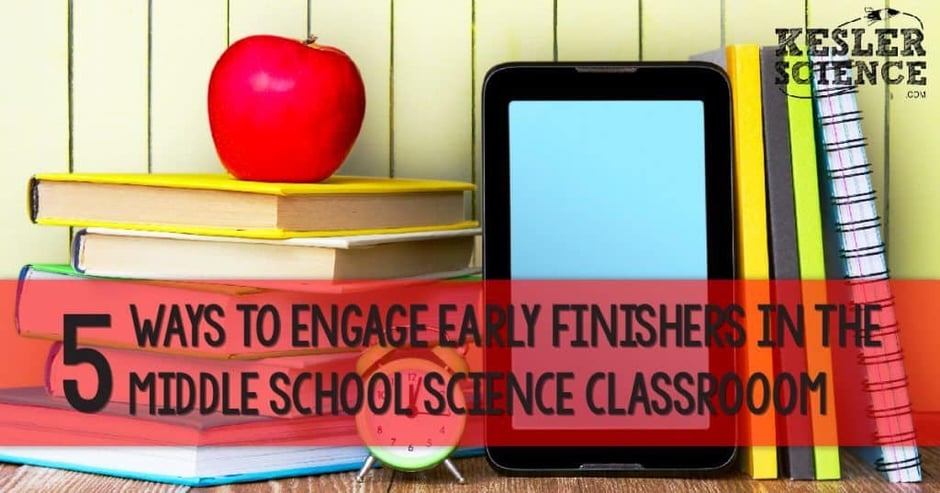Your middle school classroom probably looks a lot like mine did. The ability of your students ranges all the way from elementary to high school. The challenge becomes how to deal with students who work at different paces.
If you're running a student-centered classroom then you probably have run into the issue of finding additional activities for those students who finish their assignments early. We called them early finishers in our school.
The easy thing to do with early finishers is to simply pile on more busy work under the guise of "extra practice", but this is an injustice to students who happen to finish their work early. I'd like to suggest some alternative activities which won't come across as a punishment to your early finishers.

- Allow Them to Read - This one seems straight forward because it is. All of us wish our students would read more, and this is a perfect opportunity to allow early finishers to have some down time with a good book. Does it really matter if the book is related to the topic? No. What matters is they are reading. There are some students who won't be able to handle this much independence. In that case you may be better off with one of the other choices. The last thing you want is to have them bothering students who aren't finished with the assignment yet.
- Student Choice Project - If you're in a classroom that uses the 5E model then this is a great time to allow your early finishers to move into the extension/elaboration piece of the instruction. A student choice project is a great way to allow students to expand on their mastery of the concept. One of my favorite enrichment books for the middle school science class is called Differentiating Instruction with Menus by Laurie Westphal. Students are empowered when they get to make a choice of how to present the content. If you're able to expand their options with some technology options, then you will find some students become even more engaged.
- Stump the Teacher - Challenge early finishers to extend their knowledge about the content and try and stump you with their new found information. You could allow them to lookup relevant topics on a computer or mobile device and then report back to you with their findings. This is a great way to get the kids to dive deeper into the content. You may even have them look up a specific topic related to the content you are teaching. For example, if you're teaching about tides then have them do a little research on why the Bay of Fundy is often used to help teach tides. What makes it unique? How is it relevant to the topic?
- Make Them a SME - In my classroom I had subject matter experts (SME's). These were the students who understood the directions and content and could be called on by other students who needed a little extra help. The SME's had an elevated sense of pride in knowing they were responsible for helping their classmates with any questions they may have had. This alleviated the issue of having early finishers sit around with nothing to do. Another benefit is that the SME's made the end of the class period run more smoothly because not everyone was asking me questions. The last 5 minutes of a lab or activity can often be frantic, but having SME's made the transition easier. Empower them! They will rise to the challenge.
- Interview an Expert - There are nearly 300 million active users on Twitter. It's almost a certainty that some of these peoples work in the content area your class is studying. Have your students fire off a couple of questions to these experts to see if they can get a response. On Twitter you're limited to 140 characters, but you can definitely formulate a great question in that space. You could even setup a class Twitter account and let students use it. I would make sure you proofread any tweet or email before it gets sent out.
Example Tweets:
- I'm a 8th grade student in Houston. What inspired you to get into the field of geology?
- We're studying the planets in Mr. Kesler's 8th grade class. What kind of college classes did you take to get your job?
- I'm a 6th grader in Rosewood Middle School and we're studying ecosystems. What's the most exciting part of your job?
You don't have to rely strictly on Twitter either. It's super easy to find an email address or another social media profile for just about anyone. Part of the task is teaching students how to be resourceful to find the information they need. Last year we had a student who wanted to attend MIT and I happen to know someone that attended the school. A quick connection was made and they ended up connecting via email. I can't think of a better use of free time than making real-world connections for students. They will remember those connections forever.
Students will work at different paces in your classroom. Be there when they are finished with these meaningful activities, and they will reward you by thinking outside the box.
What are some of your best early finisher ideas? I'd love to hear about them in the comments below.
Download Over $100 in FREE Resources
For Middle School Science
Simply create a login below and gain immediate access to a selection of our Kesler Science product line worth $100 - for FREE. There's a full version of every product type! You'll also join tens of thousands of middle school science teachers who receive timely tips and strategies straight to their inbox.




